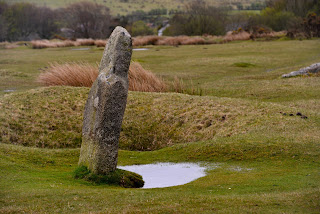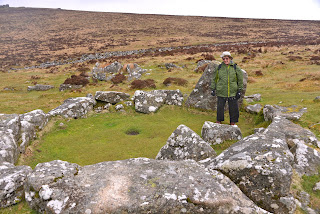I Ain’t ‘Fraid of No Ghosts. Most of the tourist shops in southern England sold small books about local ghosts (ie., the Ghosts of Dartmoor, Southern Ghost Stories, etc.). I also have a book I’d been reading at home before the trip called “Britain’s Most Haunted Pubs and Inns.” This led me to start asking at the pubs and inns we visited if there were any local spooks.
In Staple Fitzpaine near Taunton in Somerset we stayed at the Greyhound Inn which has been a coaching house and inn since the 1700s.
 |
| Greyhound Inn, Staple Fitzpaine, Somerset |
 |
| A great steak dinner |
While visiting with the landlord I jokingly asked if there were any local ghosts we could visit with. He said that while he’d never felt a presence, the kitchen staff say that sometimes they feel someone else is in the room with them when no one is about. He also said that a burly Irishman had stayed one night a couple years before. In the morning when he was asked how he’d slept, the Irishman replied, “I barely slept at all. I woke up in the middle of the night with hands around my neck and no one was there.” The landlord didn’t know if the Irishman had had a supernatural experience or just too many pints the night before.
Our next opportunity came at The Dolphin Inn in Penzance, Cornwall.
 |
| The Dolphin Inn |
We picked out this pub because of its very nice menu and reputation for food, as well as its reputation as a quite haunted inn. At least three ghosts haunt the inn: the old retired ship’s captain, a young man who had committed suicide in the pub, and an elder lady who wanders amongst the upstairs rooms. We had a pint one night and a meal the next and never did see any of the resident spirits except the ones in our pints of cider.
On our exploration of Dartmoor National Park in Devon we were told by a visitor’s centre docent to stop by the Warren House, the third highest inn in England.
 |
| The Warren House, Third Highest Inn in England |
It was quite foggy on the moor, very atmospheric, so the Warren House pub was a lovely stop with its welcoming fire (which has been going for almost 200 years). The landlord here was very chatty and when I asked about ghosts he said he wasn’t sure if the inn was haunted or not.
 |
| Landlord of the Warren House |
Our last spooky place is considered the most haunted pub in England. The Red Lion in Avebury in Wiltshire is indeed special.
 |
| Avebury Stone Circle |
The inn is in the middle of the largest ancient stone circle in the world. The Avebury circle, about 30 miles north of Stonehenge, is three-quarters of a mile around and consists of scores of very large stones.
The Red Lion Pub has numerous eating areas as well as five resident ghosts. The staff have also reported seeing a phantom horse drawn carriage pull into the inn at night and hearing the ghostly clattering of hooves in the courtyard outside the pub.
Though Prince Charles has eaten several times in the pub, not even his presence had brought any of the spirits to seek a Royal audience.
Although we weren’t successful in finding any evidence of real phantoms (now there’s an oxymoron for you), we did enjoyed the search for English ghosts.
The Moors. Our trip to the south shires of England took us through or around several of the famed English moors--areas of grasslands, heathers, fern, and stone, usually quite desolate,foreboding, and very Hound of the Baskervillean, except that they were all full of walkers or trekkers. Exmoor in Somerset and North Devon was disappointing. It was mostly stonewall-fenced farmland hidden behind tall hedges (see the last blog post). On the way from Penzance (Cornwall) to Tavistock (Devon) we got into more typical moorland on Bodmin Moor. After quite a drive along the southern England coast it was pleasant, even in light rain, to walk a half mile out to Hurler’s stone circle,
 |
| Hurlers' Stone Circle on Bodmin Moor |
one of the more ancient of the Neolithic circles. A much less strenuous 50 foot walk was needed to see Trethevy Quoit (aka. the Giant’s House)
with its 12 foot long top stone, a form of burial chamber we’ve seen more in Ireland where they are called dolmens.
It was Dartmoor though where we got the real moorland experience, complete with heavy fog and swirling mists.
 |
| Anne walking in the moors |
 |
| A Tor, a naturally sculpted rock outcropping in the moors |
We drove from our rather forgetable Mallards B&B in Tavistock to the main Dartmoor National Park Visitors’ Centre in Princetown, where we got suggestions for what to see on our one day visit to the park. First on the list was the Warren House, a great inn in the heart of the moors.
 |
| The Warren House, Dartmoor |
Then, after coffee, a flapjack (a sweet homemade oat biscuit), and some conversation, we stopped to see a clapper bridge (a stone bridge over a stream or river) in Postbridge.
Luck was with us as we had the bridge to ourselves for a few minutes before a bus of tourists arrived to swarm the bridge and get into each others’ photos.
 |
| Anne in one of the stone huts at Grimspound, Dartmoor |
It was about three miles from Postbridge to the turnoff to the trailhead of the hike up to Grimspound, a low stonewall encircled Bronze Age settlement of 24 stone huts dating to 1300 BC. For a break from the foggy moors we drove down a horrendously small road to the village of Buckfast and a visit to Buckfast Abbey,
an active working monastery.
In the abbey church I visited with Father Christopher who knew about the Mt Angel Abbey and the Benedictine Assisted Living Center where my mother is getting well cared for. After the dry weather of the abbey we headed back into the moors to find either stone circles or remains of stone huts (I couldn’t be sure which)
before again visiting Warren House for a good dinner. One interesting note about dinner at the inn was that while in the morning the specials board had listed a special of Sunday roast, by mid-afternoon the roast had been replaced with a different special. As we ate we watched the bar staff change the specials three more times--either they were one-of-a-kind or they were yesterday’s left-overs. Lastly, we wanted to see a second ancient village with a unique stone row feature.
We started out past the wild Dartmoor ponies, but soon were turned back by fog so thick we were afraid of getting lost on the trackless moor.
Although the villages of southern England, such as St Ives (made famous by the Doc Martin TV series) and Mousehole,
 |
| Mousehole harbor, a few miles from Penzance, Cornwall |
were picturesque, I much more enjoyed traipsing around Bodmin Moor and Dartmoor.
At the Theatre. A Rick Steves’ travel show turned us on to the open-air Minack Theatre at Porthcumo about four miles from Land’s End in Cornwall. We booked from home an evening performance of a Cornish Celtic Folk Group at the theatre and were looking forward to the music and to seeing the venue. When the weather on performance day turned nasty with 40 mile an hour winds and heavy rain, we decided to visit the theatre during the day knowing that the evening performance would be cancelled.
The hand-built rock amphitheater is the dream child of Rowena Cade, who used her back garden to stage a local production of The Tempest in 1932. Her work and that of a faithful gardener produced a dramatic seaside theatre which today hosts 17 plays in a season running from June through September and seen by 80,000 theatre-goers in a typical year.
As we toured the theatre in high wind and driving rain we were told that the performance would probably not be cancelled--evidently the group would perform for anyone silly enough to sit out on grass or stone seats in 40 degree wind-blown rain. We were not in attendance, but the theatre is still a highlight of our trip.
Next: More highlights from England and Scotland and our trip summary--all written from home.















Sounds like such a pleasant trip! I hope to make it out there someday.
ReplyDelete